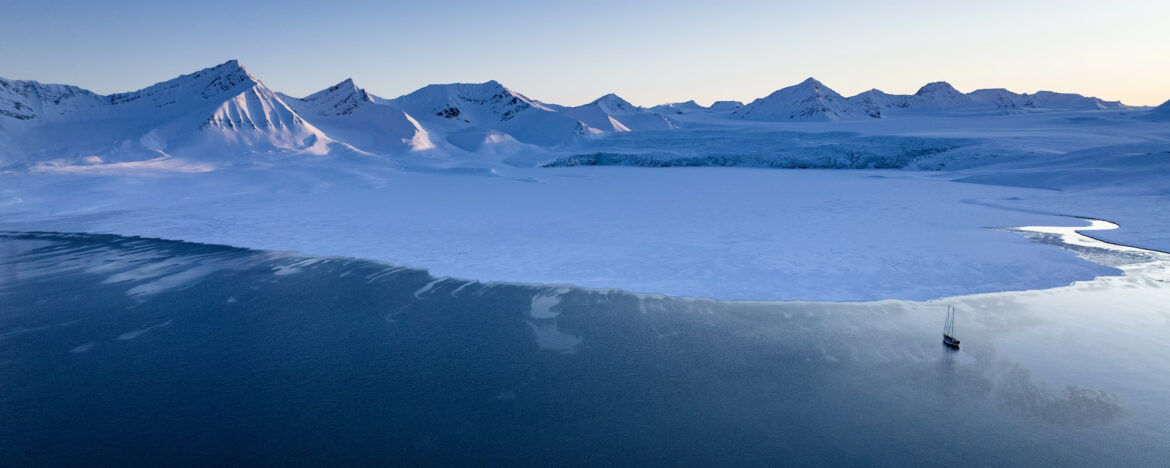Their mission was to find and survey marine animal forests, to help raise awareness of these fragile ecosystems and find clues on how to protect them. During their first series of dives, the team repeatedly drew a blank.
But on the final dive of the series they found the first marine animal forest in the Arctic, at between 50 and 80 metres in depth, made up of hydroids: animals related to jellyfish and corals that resemble bells, flowers and ferns.
Clicking on the “Read Full Article” link below will auto-scroll you to the full article (same page).
Rolex Perpetual Planet Initiative Under the Pole: DeepLife — Svalbard Expedition
Between 30 and 200 metres down, in the mesophotic zone, the ocean is dimly lit. In this twilight world, organisms including algae that depend on sunlight cannot survive.
Instead, the ecosystem is dominated by animals like corals, gorgonians (soft corals) and sponges that anchor themselves to rocks.
Conditions within these deep-water forests are more stable than in open water and have the potential to form important refuges for underwater life, though they are rarely included in marine protected areas.
And, unlike their land-based counterparts, many submarine forests remain undiscovered and misunderstood.
Under The Pole has set out to change this. As a team of both seasoned divers and marine scientists, their expeditions have taken them around the globe, where they have made pioneering scientific discoveries; raised awareness of overlooked marine ecosystems; and pushed the boundaries of deep-diving technology.
With the support of the Rolex Perpetual Planet Initiative, the programme launched an expedition series, Under The Pole IV – DEEPLIFE 2021–2030, which aims to document marine animal forests across each of the planet's oceans – helping further our understanding of these deep-sea worlds, and how best to protect them.



PRESERVING THE ARCTIC OCEAN'S “FORESTS”
For the first expedition, a team of explorers and scientists sailed the frigid seas near the Svalbard archipelago, off the north coast of Norway. Biodiversity in the Arctic is among the most threatened on Earth. It is warming faster than anywhere else and the floating sea ice that covers much of the Arctic Ocean has halved over the last 40 years.
Their mission was to find and survey marine animal forests, to help raise awareness of these fragile ecosystems and find clues on how to protect them.
During their first series of dives, the team repeatedly drew a blank. But on the final dive of the series they found the first marine animal forest in the Arctic, at between 50 and 80 metres in depth, made up of hydroids: animals related to jellyfish and corals that resemble bells, flowers and ferns.
The discovery represents an important advance in Arctic marine science, where biodiversity at this depth has long been a mystery. The divers deployed their research programme, recording the species inhabiting the forest and environmental data such as temperature.
This knowledge is shared with an international consortium of scientists to help define the significance of this rare Arctic habitat as a biodiversity hotspot, and campaign for its protection.
A DISCOVERY IN THE DEEP
At the outset, the team carefully studied maps to find the places most likely to have rich underwater life. A key clue was whether there were strong currents, which carry nutrients and sustain the marine animal forests.
To access their chosen sites, the team sailed amidst floating sea ice, in temperatures that regularly dropped to -30° C.
In order to locate the forest, team members repeatedly dived into the Arctic Ocean, at sites never explored before. Diving beyond the 30 metres typical of recreational dives, they used specialist rebreather equipment, which recycles the unused oxygen they exhaled and extends their air supply.
Without Under The Pole's extensive exploration credentials, researching these marine animal forests would be a much greater challenge. But by braving the unforgiving waters of Svalbard and making this unlikely discovery, Under The Pole has given its scientific collaborators a far better chance at progressing our understanding.
ABOUT THE PERPETUAL PLANET INITIATIVE
For nearly a century, Rolex has supported pioneering explorers pushing back the boundaries of human endeavour.
The company has moved from championing exploration for the sake of discovery to protecting the planet, committing for the long term to support individuals and organizations using science to understand and devise solutions to today's environmental challenges.
This engagement was reinforced with the launch of the Perpetual Planet Initiative in 2019, which initially focused on individuals who contribute to a better world through the Rolex Awards for Enterprise, on safeguarding the oceans as part of an established association with Mission Blue, and on understanding climate change via its longstanding partnership with the National Geographic Society.
An expanding portfolio of other partnerships embraced by the Perpetual Planet Initiative now includes: Cristina Mittermeier and Paul Nicklen in their work as conservation photographers; Rewilding Argentina and Rewilding Chile, offspring organizations of Tompkins Conservation, protecting landscapes in South America;
Coral Gardeners, transplanting resilient corals to reefs; Steve Boyes and The Great Spine of Africa series of expeditions, exploring the continent's major river basins; theUnder The Pole expeditions, pushing the boundaries of underwater exploration;
the B.I.G expedition to the North Pole in 2023, gathering data on threats to the Arctic; and the Monaco Blue Initiative, bringing together ocean conservation experts.
Rolex also supports organizations and initiatives fostering the next generations of explorers, scientists and conservationists through scholarships and grants such as Our World-Underwater Scholarship Society and The Rolex Explorers Club Grants.
For corrections or follow-up: editor@bizzinfohub
You may like these posts too:
- No related posts.














